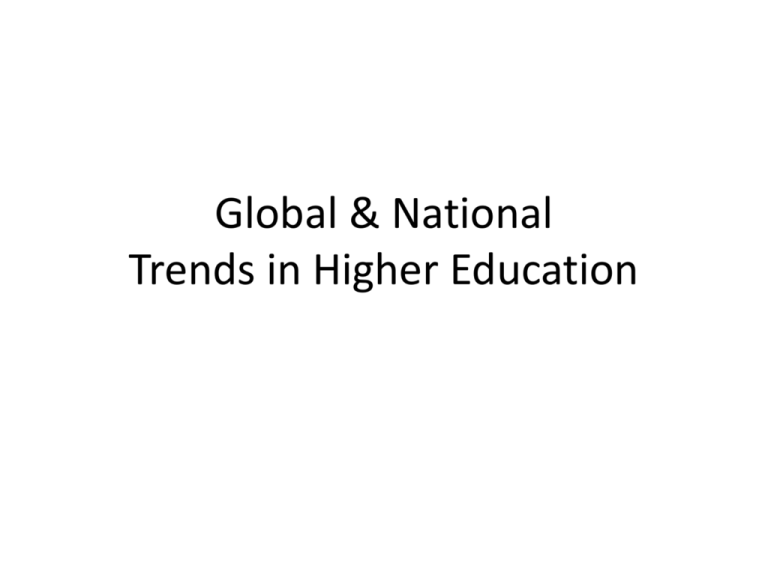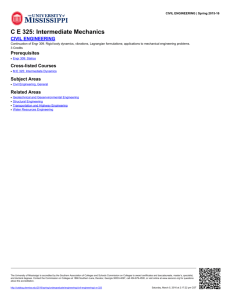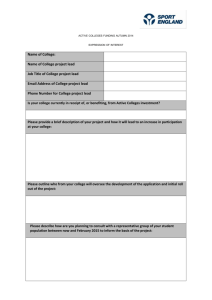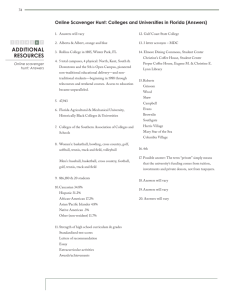Preliminary Scan of External Trends
advertisement

Global & National Trends in Higher Education Global Trends • Globalization – – – – Increasingly integrated world economy New information and communications technology Emergence of international knowledge network Role of the English language • Internationalization – Response to globalization with policies and programs such as study abroad, branch campuses oversees, and engaging in inter-institutional partnership Altbach, P. G. , Reisberg, L. & Rumbley, L. E. (2009). Trends in global higher education: Tracking an academic revolution. A Report Prepared to the UNESCO 2009 World Conference on Higher Education. The Bologna Process • Central Objective – To enhance the international competitiveness of the European system of higher education (EHEA) • Driving forces included a desire to be a student-driven and outcome-based system, and employers’ concerns in a globally-changing labor market – Membership includes 46 Nations from 1999 to 2007, and has impacts far beyond Europe Altbach, P. G. , Reisberg, L. & Rumbley, L. E. (2009). Trends in global higher education: Tracking an academic revolution. A Report Prepared to the UNESCO 2009 World Conference on Higher Education. The Bologna Process 2020 – The European Higher Education Area in the New Decade: Communiqué of the Conference of European Ministers Responsible for Higher Education, Leuven and Louvain-la-Neuve, 28-29 April 2009. The Bologna Process • This voluntary process has led to: – Initiatives to define outcomes/competencies – Discussions about recognition/transfer processes for students who have studies elsewhere – Efforts to develop transnational quality-assurance standards – Initiatives to make higher education more responsive to the needs of business an industry and help Europe become the most competitive knowledge-based economy in the worlds – Efforts to develop common curricular standards Sursock, A. & Smidt, H. (2010). Trends 2010: A decade of change in European Higher Education. ECU Publications 2010. The Bologna Process • Higher Ed participation rates have increased by 25% between 1998 and 2006. • But much work is needed to convince employers of it’s value. Sursock, A. & Smidt, H. (2010). Trends 2010: A decade of change in European Higher Education. ECU Publications 2010. Global Trends • Increased Mobility – More than 2.5 million students studied outside their home countries, and this trend is expected to increase drastically in the coming years. • Institutions are taking action to attract international students – Branch campuses, off-shore academic programs, franchising arrangements for academic degrees Sursock, A. & Smidt, H. (2010). Trends 2010: A decade of change in European Higher Education. ECU Publications 2010. Global Trends • The global demand on higher education has increased dramatically. Higher Ed enrollment ratio by region Source: UNESCO Global Trends, Figure 1 Growth in Enrollment • The National Center for Education Statistics projects a 13% growth in enrollment from 2007 to 2015. – 12% for undergraduate students – 18% for graduate students – 20% for first-time professionals Aud, S., Hussar, W., Kena, G., Bianco, K., Frohlich, L., Kemp, J., Tahan, K. (2011). The Condition of Education 2011 (NCES 2011-033). U.S. Department of Education, National Center for Education Statistics. Washington, DC: U.S. Government Printing Office. Global Trends • Privileged classes attending Higher Ed at greater rates in nearly all nations even the U.S. – Due to geography, unequal distribution of wealth and resources. Norton, M. I., & Ariely, D. Building a better America—One wealth quintile at a time. Perspectives on Psychological Science, 6(1), 9-12. (U.S) Global Trends • Private education market in 2006 approached US$400 billion worldwide. – Expected to grow especially rapidly in emerging economies. Private % of total Higher Ed Enrollments Japan & Indonesia > 70% United States < 35% Germany, New Zealand < 10% Bjarnason, S., Cheng, K-M., Fielden, J., Lemaitre, M-J., Levy, D., & Varghese, N.V. (2009). A new dynamic: Private higher education. Paris: UNESCO. Institution Types • For-profit Institution enrollment growth in U.S. Global Trends • Information and communication technology – ICTs can enhance information distribution more affordable and available anytime, anywhere Fall 2003 Fall 2004 Fall 2005 Fall 2006 Fall 2007 Fall 2008 Annual Growth Annual Growth Rate for Total Rate for Online Enrollment (US) Enrollment (US) 1.80% 23.00% 2.10% 18.20% 1.20% 36.50% 1.60% 9.70% 1.20% 12.90% 1.20% 16.90% Allen, I. E., & Seaman, J. (2010). Learning on demand: Online education in the United States, 2009. The Sloan Consortium. Babson Survey Research Group. Global Trends • Key demographic trends identified by the Organization for Cooperation and Development in 2008: – student participation will continue to expand, as will higher education systems. Only a few countries will see a contraction in student numbers; – women will form the majority in student populations in most developed countries and will substantially expand their participation everywhere; – the mix of the student population will become more varied, with greater numbers of international students, older students, part-time students, and other types; – the social base in higher education will continue to broaden, along with uncertainty about how this will affect inequalities of educational opportunities between social groups; – attitudes and policies relating to access as well as the consciousness among disadvantaged groups will change and become more central to national debates; – the academic profession will become more internationally oriented and mobile but will still be structured in accordance with national circumstances; – the activities and roles of the academic profession will be more diversified and specialized and subject to varied employment contracts; and – for many developing countries, the need for ever-expanding numbers of university teachers will mean that overall qualifications, now rather low, may not improve much, and current Changing U.S. Demographics Projected enrollment growth: 2007 to 2018 • Age – 18 to 24 9% – 25 to 34 25% – 35 and older 12% • Gender – Female – Male 16% 9% • Race/ethnicity – – – – – – White 4% Black 26% Hispanic 38% Asian or Pacific Islander 29% American Indian or Alaska Native 32% Nonresident aliens 14% Hussar, W.J., and Bailey, T.M. (2009). Projections of Education Statistics to 2018 (NCES 2009-062). National Center Changing Demographics Aud, S., Hussar, W., Kena, G., Bianco, K., Frohlich, L., Kemp, J., Tahan, K. (2011). The Condition of Education 2011 (NCES 2011-033). U.S. Department of Education, National Center for Education Statistics. Washington, DC: U.S. Government Printing Office. Changing Demographics Aud, S., Hussar, W., Kena, G., Bianco, K., Frohlich, L., Kemp, J., Tahan, K. (2011). The Condition of Education 2011 (NCES 2011033). U.S. Department of Education, National Center for Education Statistics. Washington, DC: U.S. Government Printing Office. Access to Higher Education: U.S. • Main barrier is financial – Reasons given for not pursuing further education among 18-34 year olds: • 67% reported needing to support a family • 57% preferred to work to make money • 48% simply say they can’t afford college Pew Research Center (2011). Is college worth It? College presidents, public assess value, quality and mission of higher education. Pew Social & Demographic Trends, Washington, DC. Access to Higher Education • Family income continues to predict college attendance among high school graduates Employment during College Employment percentages of 16- to 24-year old college students Aud, S., Hussar, W., Kena, G., Bianco, K., Frohlich, L., Kemp, J., Tahan, K. (2011). The Condition of Education 2011 (NCES 2011033). U.S. Department of Education, National Center for Education Statistics. Washington, DC: U.S. Government Printing Office. Employment cont. Access to Higher Education • Lack of sufficient preparation for college is another barrier • Students reporting haven taken at least one remedial college course in 2007-2008 – Differs by race/ethnicity • 36% of students overall • 45% of Black students • 43% of Hispanic students – Differs by age • 35% of ages 15 to 23 • 40% of ages 24 to 29 • 38% of ages 30 and older – Differs by college type • • • • 42% at 2-year public 39% at 4-year non-doctorate, 24% at 4-year doctorate 26% at private not-for-profit non-doctorate 22% at private not-for-profit doctorate Aud, S., Hussar, W., Kena, G., Bianco, K., Frohlich, L., Kemp, J., Tahan, K. (2011). The Condition of Education 2011 (NCES 2011033). U.S. Department of Education, National Center for Education Statistics. Washington, DC: U.S. Government Printing Office. Remedial Coursetaking • High participation rates result in high costs for students and postsecondary institutions • State and student costs estimated up to $2.3 billion American Schools, “Diploma to Nowhere,” 2008, available from annually Strong http://www.strongamericanschools.org/edin08pr/4188 (accessed September 5, 2011). – Lumina Foundation for Education’s Achieving the Dream Initiative found for new entering community college students placed into remedial education: • 15% completed their remedial education sequence in one year • 40% partially completed their sequence in one year • 46% did not begin their sequence Sue Clery, “Data Notes,” Achieving the Dream, Vol. 3, No 4, July/August, 2008, http://www.achievingthedream.org/_pdfs/datanotes/ DataNotes_JulyAugust_08.pdf (accessed November, 2009). Remedial Coursetaking • Obama’s goal that US will have the highest college attainment rate in the world by 2020 – Would require additional 781,000 degrees per year through 2025 – 42 million Americans ages 18 to 64 are college candidates, but are not prepared. • 64% of college presidents surveyed in 2011 say that it is unlikely we will achieve this goal (Is college worth it? Pew Research Center). Vandal, B. (2010). Education Commission of the States, Getting Past Go: Rebuilding the Remedial Education Bridge to College Success. Denver: Education Commission of the States. College Affordability • Cost and value – In a survey of the general public, 57% say the higher education system fails to provide students with good value for the money they and their families spend. Pew Research Center (2011). Is college worth It? College presidents, public assess value, quality and mission of higher education. Pew Social & Demographic Trends, Washington, DC. College Affordability The College Board (2010). Trends in College Pricing 2010. Princeton, NJ. The College Board. California • Net tuition and fees, after considering grant and aid and tax benefits, are lower than they were 5 years ago. The College Board (2010). Trends in College Pricing 2010. Princeton, NJ. The College Board. College Affordability • As college costs rise, student debt has risen significantly. – 53% of full-time, fullyear undergraduates received a loan in 20072008, up from 45% in 1999-2000 College Affordability • Of borrowers in the 2005 cohort (based on data from the 5 largest loan agencies): – About 37% of borrowers made timely payments without postponing. – About 26% became delinquent, and 15% became delinquent and defaulted on loans at some point in the first five years of repayment Cunningham, A. G., & Kienzl, G. S. (2011). Delinquency: The untold story of student loan borrowing. A report prepared by the Institute for Higher Education Policy College Affordability • Institution Type – Between 25 to 33% of students at 2-year institutions were making timely payments, compared to nearly half of borrowers at 4-year institutions. • Graduation Success – Many students who left without graduating had difficulty (33% became delinquent, 26% defaulted) – Students who graduated faired better (21% became delinquent and 16% defaulted) Cunningham, A. G., & Kienzl, G. S. (2011). Delinquency: The untold story of student loan borrowing. A report prepared by the Institute for Higher Education Policy Graduation Rates Associate degree completions has increased, but graduation rates still remain low (2009 rates: 14% in CA, 21% in US) Institutional Revenues • Total state appropriations for higher education institutions increased by 8% from 1989-90 to 1999-00, and by another 8% from 1999-00 to 2009-10, after adjusting for inflation. Hussar, W.J., and Bailey, T.M. (2009). Projections of Education Statistics to 2018 (NCES 2009-062). National Center for Education Statistics, Institute of Education Sciences, U.S. Department of Education. Washington, DC. Institutional Revenues • However, because of increased participation, – State appropriations per FTE student declined by 9% in 2008-09 and by another 5% in 2009-10, after adjusting for inflation. – Federal stimulus funds accounted for 3% of these state appropriations in 2008-09 and 5% in 200910. The College Board (2010). Trends in College Pricing 2010. Princeton, NJ. The College Board. Institutional Revenues The College Board (2010). Trends in College Pricing 2010. Princeton, NJ. The College Board. For-Profit Revenues For-Profit Revenues • For-Profit Institutions are profitable because they operate at much lower total cost per student than traditional institutions. Bennett, D. L., Lucchesi, A. R., & Vedder, R. K. (2010). For-profit higher education: growth, innovation and regulation. A Policy Paper from the Center for College Affordability and Productivity. Value of Higher Education Value of Higher Education • According to the AACC: – 95% of all businesses that employ graduates of community colleges give high recommendations for the training and education given in community colleges. – Community college grads dominate certain professional fields including: • Healthcare Professionals (> 50% of new nurses) • Homeland Security Careers (80% of all law enforcement officers, EMTs and firefighters) – Demand for grads will continue to grown in next ten years. Employers Raising the Bar: Employer’s Views on College Learning in the Wake of the Economic Downturn (2010). Prepared by Hart Research Associates on behalf of the Association of American Colleges and Universities. . Employers Raising the Bar: Employer’s Views on College Learning in the Wake of the Economic Downturn (2010). Prepared by Hart Research Associates on behalf of the Association of American Colleges and Universities. . Employers Raising the Bar: Employer’s Views on College Learning in the Wake of the Economic Downturn (2010). Prepared by Hart Research Associates on behalf of the Association of American Colleges and Universities. . Employers Raising the Bar: Employer’s Views on College Learning in the Wake of the Economic Downturn (2010). Prepared by Hart Research Associates on behalf of the Association of American Colleges and Universities. Academic Demands Large numbers of undergraduates report that they experience only limited academic demands and invest only limited effort in their academic endeavors. On average, students spend between 12 and 14 hours per week studying (~50% less than a few decades ago). Arum, R. Roksa, J. & Esther, C. (2009). Improving undergraduate learning: Findings and policy recommendations from the SSRC-CLA longitudinal project. Social Science Research Council. Academic Success • Academically Adrift: Limited Learning on College Campuses (University of Chicago Press, 2011) – This recent publication, that has gained significant media press, tracked learning gains of a sample of 2,000 four-year institutions using the CLA • 45% of students did not demonstrate any significant improvement in learning in the first two years • 36% of students did not demonstrate any significant improvement in learning in after four years. Arum, R., & Roksa, J. (2011). Academically adrift: Limited learning on college campuses. Chicago: University of Chicago Press. Academically Adrift • Students who spent more hours studying alone had greater gains (opposite with peers) • Students who took courses requiring both significant reading (>40 pages per week) and writing (> 20 pages) had greater gains • Students reporting faculty with higher expectations at their institutions had higher gains • Students who had more advanced coursework in high school had greater subsequent college gains Successful Community Colleges • A recent study of 6 Texas Community Colleges with higher-than expected transfer rates found three commonalities: – Structured academic pathways – Student-centered culture that emphasizes personal attention – Culturally sensitive leaders who understand the backgrounds of their students Smith, C. T., Miller, A, & Bermeo, C. A. (2009). Bridging the Gaps: Promising Practices for Promoting Transfer among Low-Income and First Generation Students. The Pell Institute for the Study of Opportunity in Higher Education. Grade Inflation Source: Teachers College Record, 2009 Grade Inflation Students of Today • For first-year students just out of high school, most born in 1993 – There has always been an Internet ramp onto the info highway – There has always been at least two women on the Supreme Court – Adult experts have constantly fretted about their alleged deficits of empathy and concentration – Their school’s blackboards have always been getting smarter – American tax forms have always been available in Spanish – More Americans have always traveled to Latin America than to Europe – Amazon has never just been a river in South America – Women have never been too old to have children – The Communist Party has never been the official political party in Russia – Video games have always had ratings – First generation to grow up hearing about the dangerous overuse of antibiotics – Public schools have always made space available for advertising – Charter schools have always been an alternative – They’ve often broken up with their significant others via texting, Facebook, or MySpace Beloit College, The Mindset List, 2015 List. http://www.beloit.edu/mindset/2015/ Trends in Student Satisfaction • National Satisfaction and Priorities 15-year Trend Report: Community Colleges Observation 1What is most important has stayed important National student satisfaction and priorities 15year trend report: Community colleges. Findings and observations from 1994-1995 to 2009-2010. 2011 Research Report prepared by Noel-Levitz. Trends in Student Satisfaction • The following have shifted up in importance by 7 ranking spots or more Trends in Student Satisfaction • The following have shifted down in importance by 8 ranking spots or more Trends in Student Satisfaction • Satisfaction levels have risen overall at community colleges – Statistically significant improvements were identified in 69 out of 70 standard items on the survey. – Satisfaction levels have also risen at four-year public and private institutions. • Community college satisfaction levels are general higher than four-year private and public institutions. – A few important items have seen a decrease. These include the perception of the quality of instruction in most classes and the amount of available student parking. Redesign Initiatives • National Center for Academic Transformation (NCAT) – Worked with numerous institutions to improve quality and reduce cost in higher education by using technology to redesign learning. – Critical factors: » Eliminating lecture and using interactive computer software combined with personalized, on-demand assistance » Example: Mathematics software (ALEKS, Hawkes Learning Systems, MyMahtLab) allows students to spend more time on task, and they receive instant feedback. The National Center for Academic Transformation (2011). Retrieved September 5, 2011, from http://www.thencat.org/whoweare.html Redesign Initiatives • NCAT Success – 25 out of 30 projects showed significant increases in student learning. – Student and instructor satisfaction increased – 30 projects using NCAT’s redesign methodology had an average cost reduction of 37%. • The National Center for Public Policy and Higher Education estimated that cost of instruction for all U.S. colleges and universities would decrease by 16% annually if an institution adopted NCAT’s methods for their top 25 courses, and student learning would improve. Source: NCPPHE, 2005, http://www.highereducation.org/reports/pa_core/possibilities.shtml Redesign Initiatives • Other Course Redesign Efforts: Cal State: Remedial Math Colorado State University: Essential IT Skills East Carolina University: Chemistry Florida International University: English Composition Glendale Community College: Developmental English Glendale Community College: Learning Options Harvard University: Undergraduate Science Indiana University: Physics Kansas State University: Introductory Psychology Michigan State: Physics New England Tech: Technical Writing North Carolina State University: Physics Northern Arizona University: Psychology Penn State: Spanish Rockford Business College: Introduction to Computers Rutgers: First-year Introductory Courses University of Maryland-Baltimore County: Science University of Massachusetts at Amherst: Chemistry University of Mississippi: College Algebra and Elementary Statistics University of Mississippi: Geospatial Science University of Nebraska-Lincoln: Crop Technology University of North Texas: Library and Information Sciences University of Southern Mississippi: College Algebra University of Texas: Engineering Graphics University of Western Ontario: Teacher Education University of Wisconsin-Madison: Engineering Virginia Union University: English, Psychology, and Drama References • Allen, I. E., & Seaman, J. (2010). Learning on demand: Online education in the United States, 2009. The Sloan Consortium. Babson Survey Research Group. • Altbach, P. G. , Reisberg, L. & Rumbley, L. E. (2009). Trends in global higher education: Tracking an academic revolution. A Report Prepared to the UNESCO 2009 World Conference on Higher Education. • Aud, S., Hussar, W., Kena, G., Bianco, K., Frohlich, L., Kemp, J., Tahan, K. (2011). The Condition of Education 2011 (NCES 2011033). U.S. Department of Education, National Center for Education Statistics. Washington, DC: U.S. Government Printing Office. • Arum, R. Roksa, J. & Esther, C. (2009). Improving undergraduate learning: Findings and policy recommendations from the SSRC-CLA longitudinal project. Social Science Research Council. • Arum, R., & Roksa, J. (2011). Academically adrift: Limited learning on college campuses. Chicago: University of Chicago Press. • Bennett, D. L., Lucchesi, A. R., & Vedder, R. K. (2010). For-profit higher education: growth, innovation and regulation. A Policy Paper from the Center for College Affordability and Productivity. • Bjarnason, S., Cheng, K-M., Fielden, J., Lemaitre, M-J., Levy, D., & Varghese, N.V. (2009). A new dynamic: Private higher education. Paris: UNESCO. • Cunningham, A. G., & Kienzl, G. S. (2011). Delinquency: The untold story of student loan borrowing. A report prepared by the Institute for Higher Education Policy. • Hussar, W.J., and Bailey, T.M. (2009). Projections of Education Statistics to 2018 (NCES 2009-062). National Center for Education Statistics, Institute of Education Sciences, U.S. Department of Education. Washington, DC. • Leuven and Louvain-la-Neuve . The Bologna Process 2020 – The European Higher Education Area in the New Decade: Communiqué of the Conference of European Ministers Responsible for Higher Education, 28-29 April 2009. References cont. • Norton, M. I., & Ariely, D. Building a better America—One wealth quintile at a time. Perspectives on Psychological Science, 6(1), 9-12. • Pew Research Center (2011). Is college worth It? College presidents, public assess value, quality and mission of higher education. Pew Social & Demographic Trends, Washington, DC. • Smith, C. T., Miller, A, & Bermeo, C. A. (2009). Bridging the Gaps: Promising Practices for Promoting Transfer among LowIncome and First Generation Students. The Pell Institute for the Study of Opportunity in Higher Education. • Sursock, A. & Smidt, H. (2010). Trends 2010: A decade of change in European Higher Education. ECU Publications 2010. • Vandal, B. (2010). Education Commission of the States, Getting Past Go: Rebuilding the Remedial Education Bridge to College Success. Denver: Education Commission of the States. • Beloit College, The Mindset List, 2015 List. http://www.beloit.edu/mindset/2015/ • National student satisfaction and priorities 15-year trend report: Community colleges. Findings and observations from 19941995 to 2009-2010. 2011 Research Report prepared by Noel-Levitz. • Raising the Bar: Employer’s Views on College Learning in the Wake of the Economic Downturn (2010). Prepared by Hart Research Associates on behalf of the Association of American Colleges and Universities. • Sue Clery, “Data Notes,” Achieving the Dream, Vol. 3, No 4, July/August, 2008, http://www.achievingthedream.org/_pdfs/datanotes/DataNotes_JulyAugust_08.pdf (accessed November, 2009). • Strong American Schools, “Diploma to Nowhere,” 2008, available from http://www.strongamericanschools.org/edin08pr/4188 (accessed September 5, 2011). References cont. • The College Board (2010). Trends in College Pricing 2010. Princeton, NJ. The College Board. • The National Center for Academic Transformation (2011). Retrieved September 5, 2011, from http://www.thencat.org/whoweare.html • The National Center for Public Policy and Higher Education (2005). Policy Alert: What are the Possibilities? Retrieved September 5, 2011, from http://www.highereducation.org/reports/pa_core/possibilities.shtml






